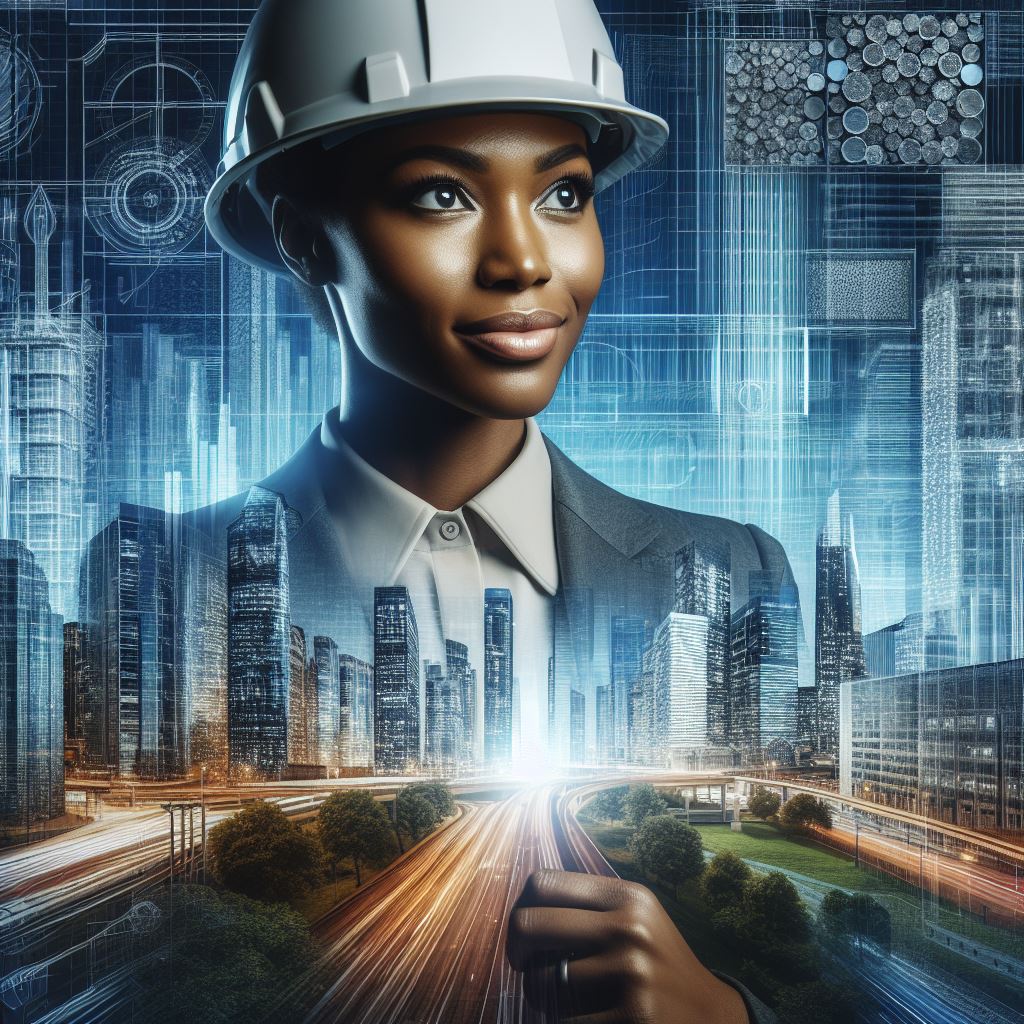Introduction
In this blog post, we will explore New York Skyline Commercial Projects.
New York City’s skyline is an iconic symbol recognized around the globe.
With its awe-inspiring buildings and landmarks, such as the Empire State Building and One World Trade Center, the city’s skyline is a testament to its vibrant energy and bustling economy.
Commercial projects in the city hold significant value in shaping the skyline’s ever-changing landscape.
These projects not only contribute to the aesthetic appeal of the city but also reflect the economic growth and development occurring within its boundaries.
As developers undertake ambitious projects, a new generation of skyscrapers and modern architectural marvels emerge, altering the city’s silhouette.
These commercial projects often become iconic landmarks themselves, further enhancing the city’s status as a global leader in commerce and innovation.
The skyline acts as a visual narration of New York City’s economic progress, showcasing the city’s ambition and entrepreneurial spirit.
Each new addition to the skyline represents a milestone, a testament to the city’s resilience and ability to adapt to ever-changing market demands.
These commercial projects have a profound impact on the city’s identity.
They not only provide office spaces but also contribute to the city’s social fabric, offering lifestyle amenities, retail spaces, and recreational areas to residents and visitors alike.
In essence, the significance of commercial projects in shaping New York City’s skyline cannot be overstated.
By creating new architectural wonders, these projects contribute to the city’s allure and act as a visual representation of its economic prosperity and cultural vibrancy.
As the city continues to evolve, we can expect more awe-inspiring commercial projects to redefine its skyline in the coming years.
Current Commercial Landmarks in New York City
Prominent commercial buildings
The Empire State Building, with its rich history and classic Art Deco style, has become an emblem of the city itself.
Transform Your Real Estate Decisions
Unlock personalized real estate insights crafted just for you. Get actionable advice designed to amplify your success.
Get StartedFeatured in numerous movies like “King Kong” and “Sleepless in Seattle,” it is instantly recognizable and evokes a sense of nostalgia for a bygone era.
Its observation deck, on the 86th floor, offers unparalleled views of New York City, attracting millions of tourists each year.
One World Trade Center, on the other hand, carries a profound emotional weight.
Rising from the site of the World Trade Center’s Twin Towers, it stands as a symbol of resilience and serves as a tribute to the lives lost in the 9/11 attacks.
The tower’s spire reaches 1,776 feet, commemorating the year of America’s independence. It represents hope and renewal in the face of tragedy.
Their architecture, height, and cultural impact.
Empire State Building
Built in Art Deco style, this 1,454-foot-tall marvel held the title of the world’s tallest building for nearly four decades.
Its distinctive spire adds to its grandeur.
Offering breathtaking 360-degree views of the city, it has been featured in numerous films and pop culture references, making it a beloved icon.
One World Trade Center
Designed by architect David Childs, this 1,776-foot-tall tower is a testament to modern architectural brilliance.
Its sleek glass façade and tapering form represent progress and hope.
Serving as the main building of the World Trade Center complex, it houses various offices, a museum, and an observation deck.
The building’s symbolic significance honors the memory of the lives lost on September 11, 2001, and stands as a symbol of resilience and renewal.
Both of these commercial landmarks in New York City contribute significantly to the city’s identity and cultural landscape.
Their stunning architecture and imposing height capture the imaginations of locals and visitors alike.
Showcase Your Real Estate Business
Publish your company profile on our blog for just $200. Gain instant exposure and connect with a dedicated audience of real estate professionals and enthusiasts.
Publish Your ProfileThese landmarks have not only transformed the city’s skyline but have also become cultural touchstones.
They are ingrained in the collective consciousness of New Yorkers and visitors, symbolizing the spirit and ambition of the city.
Both buildings serve as a testament to the architectural wonders that can be achieved when human creativity and determination converge.
As we look towards the future, New York’s skyline is set to change once again with new and exciting commercial projects on the horizon.
This evolution ensures that the city will continue to captivate our imagination and inspire generations to come.
Read: Eco-Friendly Construction: The Future in the US
Importance of Commercial Projects in New York City
Economic significance: contribution to GDP, job creation, and tax revenue
In a bustling city like New York, commercial projects play a crucial role in driving the economy.
These projects bring substantial economic benefits, contributing to the city’s Gross Domestic Product (GDP), creating jobs, and generating tax revenue.
- Contribution to GDP: New York City’s commercial projects significantly contribute to its GDP, making it a global economic powerhouse.
The construction and operation of these projects stimulate economic growth and attract investments, both locally and globally. - Job creation: Commercial projects are a major source of employment in New York City.
From construction workers to architects, engineers, and support staff, these projects provide numerous job opportunities, boosting the local economy. - Tax revenue: The completion of commercial projects results in increased tax revenue for the city.
Taxes levied on commercial properties, sales tax from businesses, and income tax from employees all contribute to the city’s financial resources, supporting public services and infrastructure development.
Symbolic importance: representing the city’s ambition, innovation, and global prominence
Commercial projects in New York City hold significant symbolic importance beyond their economic impact.
They serve as powerful symbols of the city’s ambition, innovation, and global prominence.
- Ambition: The iconic skyline of New York City reflects its ambitious nature, with commercial projects pushing boundaries and redefining architectural standards.
These projects demonstrate the city’s determination to stay at the forefront of development and progress. - Innovation: New York City’s commercial projects often showcase cutting-edge design and technological advancements.
They are platforms for innovation, attracting creative minds and fostering a culture of innovation in various industries. - Global prominence: The skyline of New York City, adorned with magnificent commercial projects, is instantly recognizable worldwide.
It serves as a symbol of the city’s global prominence, influencing the perception of New York as a dynamic and influential center for business and finance.
In fact, commercial projects in New York City hold immense importance for both the economy and the city’s image.
They contribute significantly to the GDP, create employment opportunities, and generate tax revenue.
These projects symbolize the city’s ambition, innovation, and global prominence, reinforcing New York City’s position as a leading global destination for commerce and development.
Read: 2024’s Top Commercial Developments in the US
Overview of New York’s Commercial Projects for 2024
Current and upcoming projects happening in the city
One of the most highly anticipated projects in New York City is the One Vanderbilt tower.
The One Vanderbilt tower is being developed by SL Green Realty Corp and will be located in Midtown Manhattan.
This commercial skyscraper will stand at an impressive height of 1,401 feet and have 67 floors.
The One Vanderbilt tower is designed by Kohn Pedersen Fox Associates and will feature a stunning glass facade.
Another notable project is the Hudson Yards development on the West Side of Manhattan.
Hudson Yards will include several commercial and residential buildings, as well as a public plaza.
One of the standout structures in Hudson Yards is 30 Hudson Yards, a building with 90 floors.
30 Hudson Yards will feature an observation deck on the 100th floor, offering breathtaking city views.
In Lower Manhattan, the World Trade Center site continues to be a hub for commercial development.
One of the upcoming projects at the World Trade Center is 2 World Trade Center.
2 World Trade Center is designed by renowned architect Bjarke Ingels and will have 82 floors.
The tower will have a unique and striking design, with stacked volumes that create terraces and outdoor spaces.
Other notable projects include the Moynihan Train Hall in Midtown, which will expand Penn Station’s capacity.
The Moynihan Train Hall will feature a grand skylight and serve as a new gateway to the city.
The Empire Station Complex project aims to transform Penn Station into a world-class transportation hub.
This project will include a new terminal, retail space, and much-needed upgrades to the existing infrastructure.
Showcase Your Real Estate Business
Publish your company profile on our blog for just $200. Gain instant exposure and connect with a dedicated audience of real estate professionals and enthusiasts.
Publish Your ProfileTheir scale, location, and architectural features
One Vanderbilt tower in Midtown Manhattan will be an impressive skyscraper standing at 1,401 feet with 67 floors.
The tower’s architectural design features a stunning glass facade, adding to New York City’s iconic skyline.
Hudson Yards on the West Side of Manhattan will consist of multiple commercial and residential buildings.
30 Hudson Yards, a standout structure in the development, will have 90 floors and an observation deck on the 100th floor.
2 World Trade Center will be a notable addition to the Lower Manhattan skyline with its 82 floors.
Designed by Bjarke Ingels, the tower’s unique stacked volume design will create terraces and outdoor spaces.
The Moynihan Train Hall in Midtown will expand Penn Station’s capacity and serve as a new gateway to the city.
This project features a grand skylight, adding a dramatic architectural element to the train hall.
The Empire Station Complex project aims to transform Penn Station into a world-class transportation hub.
With a new terminal and retail space, this project will significantly enhance the existing infrastructure.
In short, New York City’s commercial projects for 2024 showcase the city’s continuous growth and development.
From the towering One Vanderbilt to the transformative Hudson Yards and World Trade Center projects, these developments will shape the city’s skyline and provide enhanced spaces for commerce, transportation, and public enjoyment.
The architectural features, such as glass facades, unique designs, and grand skylights, add to the aesthetic appeal and functionality of these projects.
New York City’s skyline is ever-evolving, and 2024 will mark another significant chapter in the city’s architectural history.
Read: Retail Real Estate Loans: A Comprehensive Guide

Hudson Yards Development
The largest development project in Manhattan’s history
The Hudson Yards Development is the most significant project ever undertaken in Manhattan.
Spanning 28 acres, it is a massive endeavor that is reshaping the city’s skyline.
The project aims to create a new neighborhood that combines residential, commercial, and retail spaces.
It is a joint venture between Related Companies and Oxford Properties Group.
The estimated cost of this development is a staggering $25 billion, making it an unparalleled undertaking.
Its impact on the cityscape, economy, and urban living
The Hudson Yards Development will dramatically transform the cityscape of New York.
It will introduce numerous skyscrapers, creating a stunning visual presence in the city.
The centerpiece of the project is 30 Hudson Yards, a towering structure that will stand at 1,296 feet.
These new buildings will redefine the city’s skyline, adding a modern touch to its iconic image.
The development will also bring a multitude of economic benefits to New York City.
It is expected to generate tens of thousands of jobs during construction and ongoing operations.
The retail and commercial spaces within the project will attract new businesses, further boosting the local economy.
The increased flow of people into the area will drive up property values in surrounding neighborhoods.
The Hudson Yards Development is not only about buildings and economics; it also focuses on improving urban living.
The project will offer a range of residential options, from luxury apartments to affordable housing.
Showcase Your Real Estate Business
Publish your company profile on our blog for just $200. Gain instant exposure and connect with a dedicated audience of real estate professionals and enthusiasts.
Publish Your ProfileThis diverse selection will cater to the needs of various income groups and ensure a vibrant community.
The development will feature extensive green spaces, parks, and public plazas for recreational activities.
These outdoor areas will provide residents and visitors alike with opportunities to engage with nature and enjoy a better quality of life.
The inclusion of state-of-the-art amenities, such as fitness centers, schools, and cultural institutions, will foster a sense of community and convenience.
The Hudson Yards Development aims to create a sustainable urban environment, incorporating energy-efficient technologies and green design principles.
This commitment to sustainability aligns with New York City’s goal of becoming a greener and more eco-friendly metropolis.
In general, the Hudson Yards Development is a groundbreaking project that will reshape Manhattan’s landscape.
With its massive scale and significant investment, it is set to become an iconic neighborhood.
The project’s impact on the cityscape, economy, and urban living will be far-reaching.
It will redefine the skyline, bolster the economy, and provide a new standard for urban living.
The Hudson Yards Development represents a bold vision for the future of New York City, embracing innovation and sustainability.
Read: Emerging CRE Markets: 2024 Guide
One Vanderbilt Tower
Information about the skyscraper located in Midtown Manhattan
One Vanderbilt Tower is a skyscraper located in Midtown Manhattan, one of New York City’s prominent business districts.
The tower stands at a height of 1,401 feet, making it one of the tallest buildings in the city.
Its construction began in 2016, with the aim of providing state-of-the-art office space and amenities.
One Vanderbilt Tower boasts a sleek and modern design, featuring a glass curtain wall facade.
The tower is set to serve as the headquarters for various global companies and organizations.
It will offer approximately 1.7 million square feet of Class A office space spread across 67 floors.
The skyscraper will also provide direct access to Grand Central Terminal, a key transportation hub in the city.
This convenient location will allow businesses and employees to connect easily to various parts of the city.
One Vanderbilt Tower aims to expand Midtown’s business district and bring new opportunities for economic growth.
By providing additional office space, the tower encourages companies to establish a presence in Midtown Manhattan.
This expansion will create job opportunities and contribute to the city’s overall economic development.
Its role in expanding Midtown’s business district and revitalizing the surrounding area
In addition to its economic impact, the tower plays a vital role in revitalizing the surrounding area.
The project incorporates public spaces and amenities that will enhance the overall business and cultural experience.
The base of the tower will have a public plaza spanning 14,000 square feet, offering a lush oasis amidst the bustling city.
The plaza will feature artwork, outdoor seating, and retailers, creating a vibrant and attractive gathering space.
By activating the street level, the tower contributes to the ongoing revitalization efforts of Midtown Manhattan.
The development also includes infrastructure improvements, such as upgraded subway entrances and pedestrian walkways.
These enhancements will improve connectivity and accessibility for both residents and visitors in the area.
Showcase Your Real Estate Business
Publish your company profile on our blog for just $200. Gain instant exposure and connect with a dedicated audience of real estate professionals and enthusiasts.
Publish Your ProfileMoreover, the skyscraper’s sustainable design incorporates various environmentally friendly features.
One Vanderbilt Tower aims to achieve LEED Gold certification, ensuring energy efficiency and environmental responsibility.
The tower will utilize efficient HVAC systems, optimized natural lighting, and water-saving fixtures.
Additionally, the development includes green spaces and landscaping to promote biodiversity and reduce the heat island effect.
By prioritizing sustainability, the tower showcases New York City’s commitment towards a greener future.
One Vanderbilt Tower stands as a significant addition to Midtown Manhattan’s skyline.
It not only provides modern office space but also plays a pivotal role in expanding the business district.
The skyscraper’s contribution to the revitalization of the surrounding area further highlights its importance.
With its sustainable design and commitment to creating a vibrant public space, One Vanderbilt Tower sets a new standard for commercial projects in New York City.
The Spiral
Unique Design and Features
The Spiral is an upcoming office building in New York City that promises to redefine the city skyline.
Designed by Bjarke Ingels Group (BIG), this 66-story skyscraper stands out with its spiral shape.
The unique architectural design of The Spiral creates a stunning visual impact and sets it apart from other buildings.
The building gradually twists as it rises, giving it a dynamic and fluid appearance.
The Spiral will have 2.85 million square feet of space, offering ample room for offices and commercial activities.
With floor-to-ceiling windows, The Spiral provides breathtaking panoramic views of the city and its surroundings.
The building features open and flexible floor plans to accommodate the diverse needs of modern businesses.
A grand outdoor terrace on the 32nd floor will provide a unique space for relaxation and social gatherings.
The Spiral also includes state-of-the-art amenities like fitness centers, conference rooms, and upscale restaurants.
To ensure convenience for occupants, the building will have multiple high-speed elevators with efficient vertical transportation.
Sustainable and Innovative Aspects
The Spiral is designed to be a sustainable and environmentally friendly skyscraper.
The building will feature a stunning landscaped atrium, offering a natural environment within the urban setting.
The atrium will contain an abundance of greenery, creating a pleasant and refreshing space for occupants.
The Spiral will use advanced technologies to minimize its environmental impact and reduce energy consumption.
A system of energy-efficient HVAC (heating, ventilation, and air conditioning) will be installed to optimize energy usage.
The building will also employ efficient water management systems, including rainwater harvesting and recycling.
The use of solar panels and renewable energy sources will further contribute to its sustainability goals.
The Spiral intends to achieve LEED (Leadership in Energy and Environmental Design) Platinum certification.
The construction materials chosen for the building will be environmentally friendly and sustainable.
In addition to its sustainable features, The Spiral will also offer innovative amenities like cutting-edge technology infrastructure.
The building will incorporate smart systems to enhance security, convenience, and overall user experience.
Showcase Your Real Estate Business
Publish your company profile on our blog for just $200. Gain instant exposure and connect with a dedicated audience of real estate professionals and enthusiasts.
Publish Your ProfileIn terms of transportation, The Spiral aims to promote the use of public transit and reduce the reliance on private vehicles.
The building will have dedicated bicycle parking facilities and encourage the use of green commuting options.
The Spiral’s commitment to sustainability and innovation makes it a compelling choice for forward-thinking businesses.
It sets a new standard for environmentally conscious architecture, promoting a greener and more livable city.
In a nutshell, The Spiral stands out as a remarkable addition to New York City’s skyline.
Its unique design and features create a visually stunning building that will become an iconic symbol of modern architecture.
Additionally, its commitment to sustainability and innovation ensures that it will be a leader in environmentally conscious development.
The Spiral is bound to attract businesses and professionals seeking a forward-thinking and sustainable workspace in the heart of the city.
Find Out More: Smart Buildings: A Real Estate Shift
Conclusion
Commercial projects stand as the bedrock of New York’s skyline, mirroring the city’s ever-evolving economic vitality and cultural dynamism.
Without these projects, the skyline would lack its distinctive character and global allure, underscoring their paramount importance in shaping the city’s identity.
Looking ahead, the anticipation for future developments is palpable, promising to inject fresh energy and innovation into New York’s architectural tapestry.
These upcoming projects hold the potential to redefine the skyline, offering new perspectives and experiences that will captivate residents and visitors alike.
As cranes dot the horizon and blueprints come to life, the city embarks on a journey of transformation, embracing the spirit of progress and reinvention that has long defined its essence.
With each skyscraper reaching for the heavens, New York reaffirms its status as a beacon of innovation and ambition, symbolizing the limitless possibilities that await in the concrete jungle.
As we bid farewell to the present skyline, we eagerly await the dawn of a new era, where towering marvels will etch their mark on the cityscape, perpetuating New York’s legacy as a global icon of urban grandeur and aspiration.




